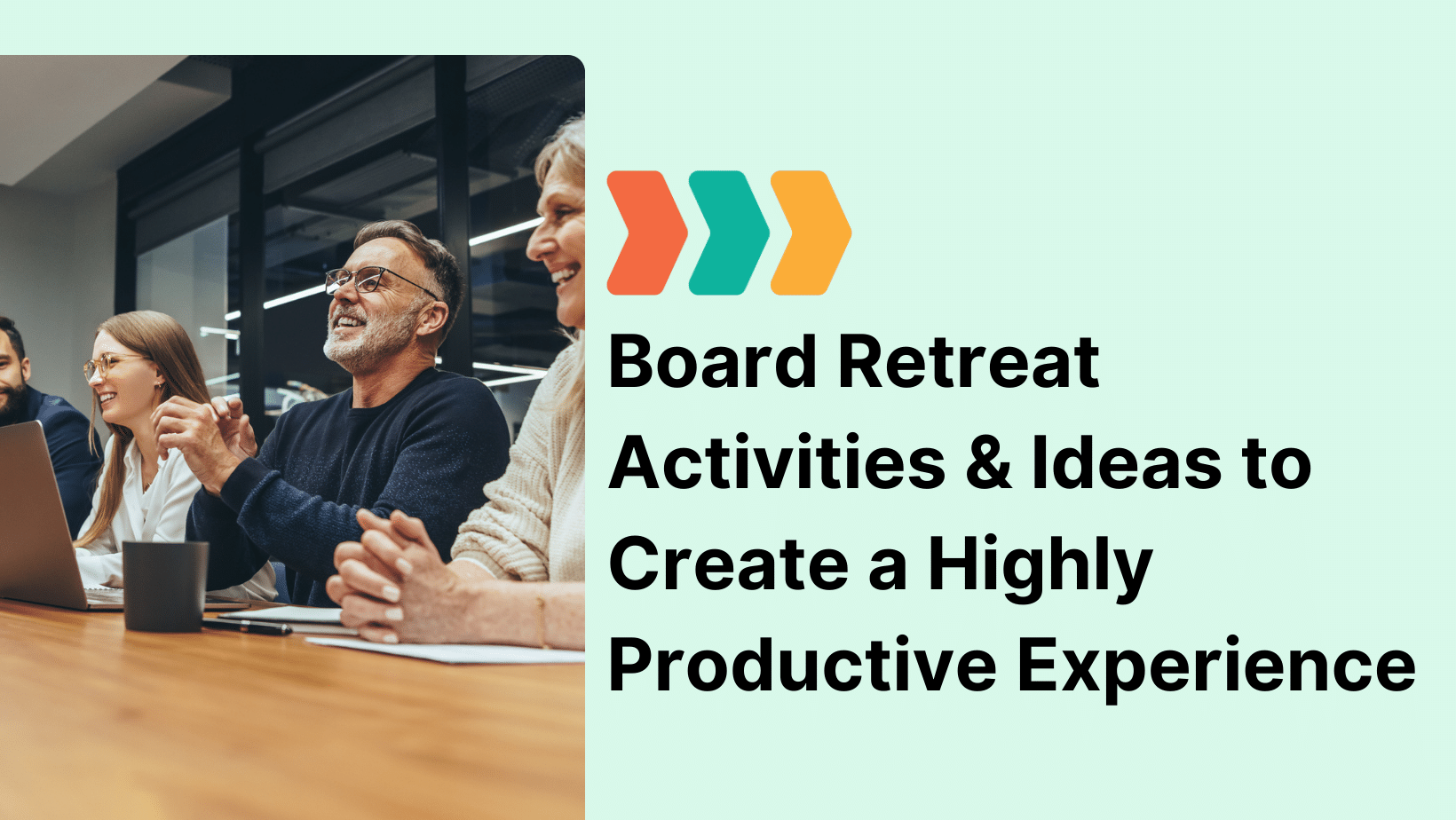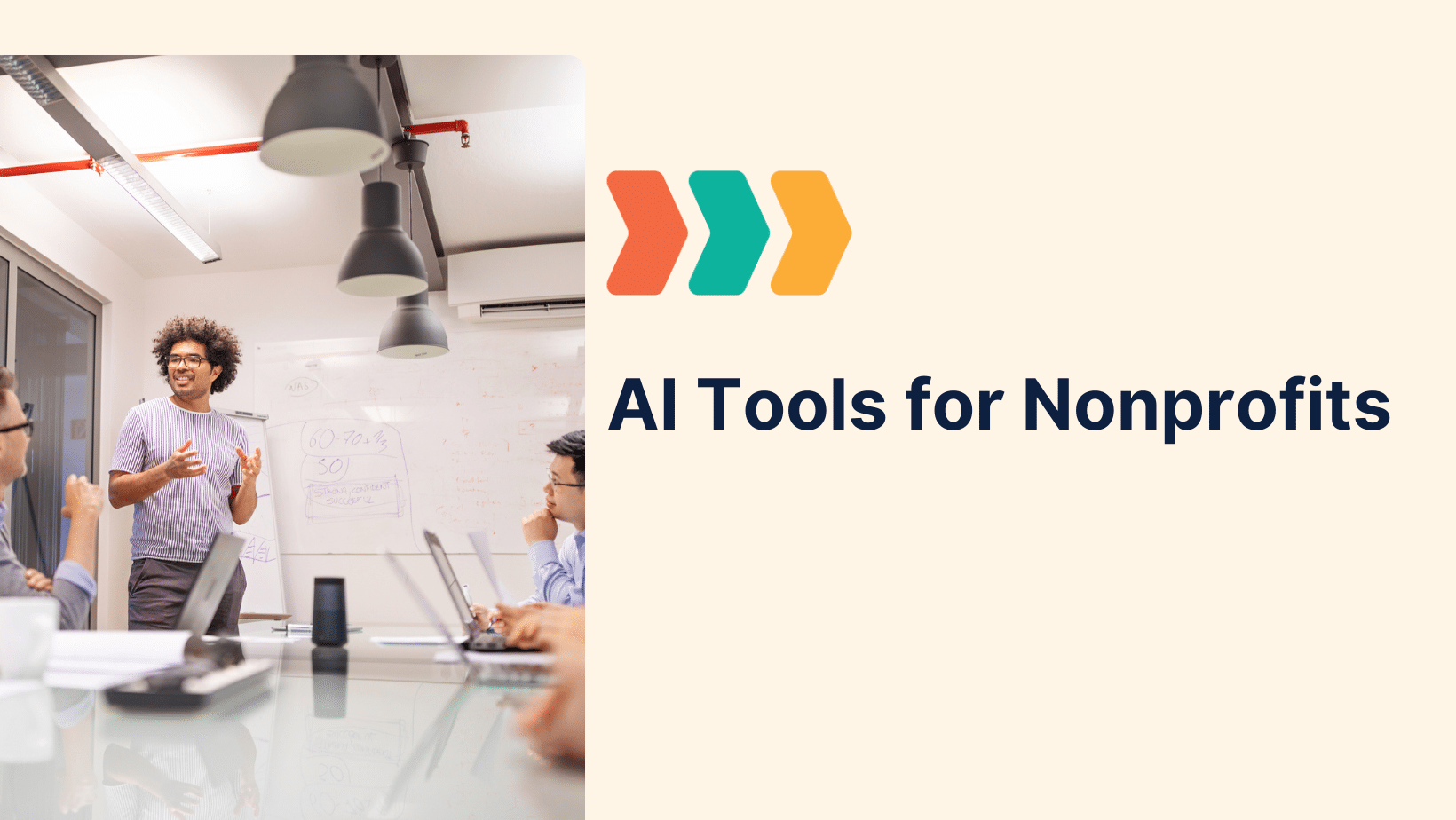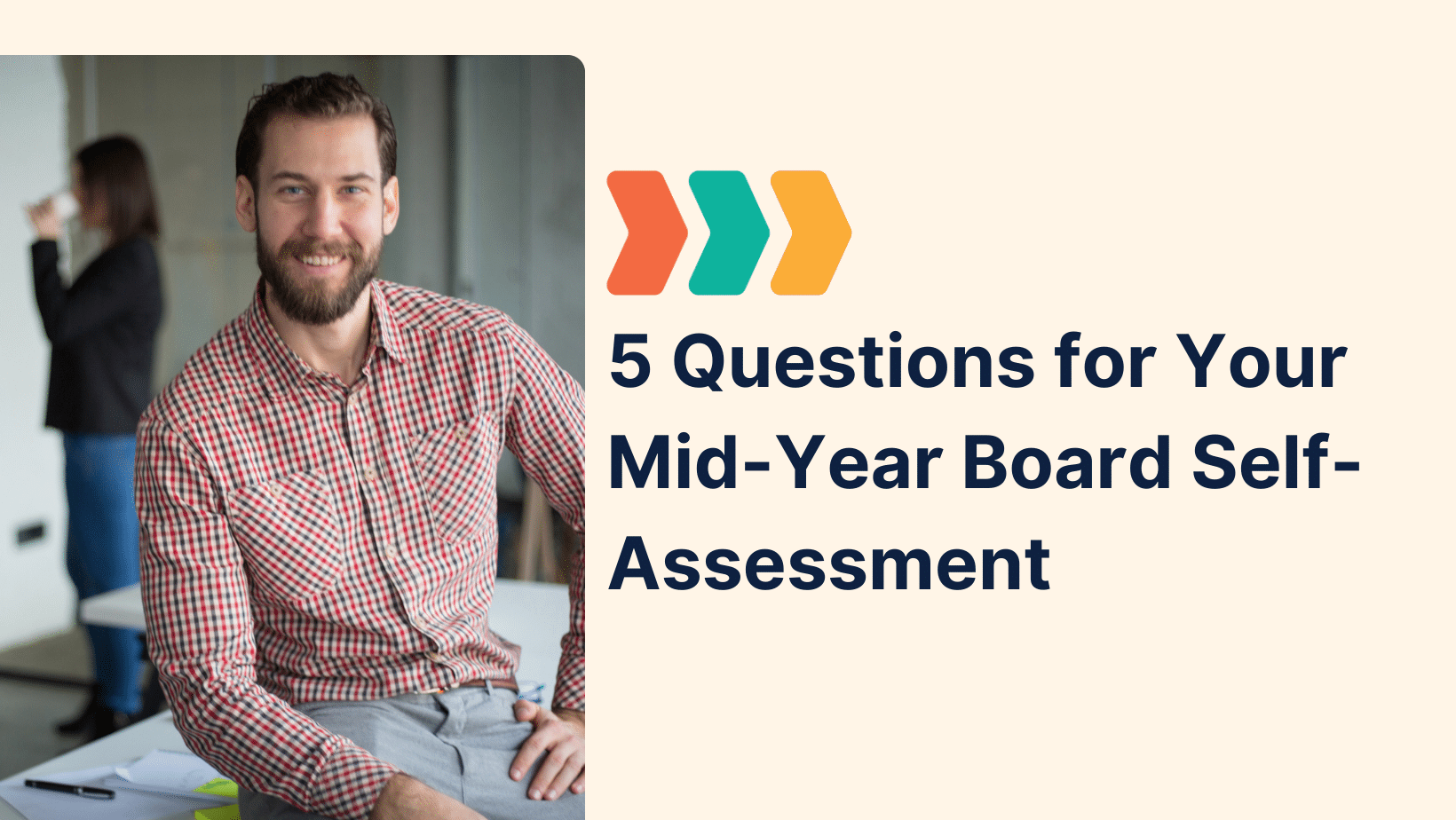You have periodic performance assessments at work. Students receive grades and evaluations throughout the year. Why are nonprofit boards and volunteer organizations any different? If something is worth spending your precious time on, it is worth checking in periodically to identify areas for improvement.
Nonprofit boards sometimes suffer from a mindset of “We’re asking people to volunteer and give, so we shouldn’t ask anything more of them.” In reality, people are involved in your organization because they care about the mission and want to increase impact in the community. Board members should actually welcome performance feedback and an opportunity to improve!
Still, if there is no expectation of board evaluations from time to time, it may be a shock to some the next time leadership decides to conduct one. In this guide, we lay out the who, what, when, and why of evaluations, as well as best practices for preparing for and conducting them.
Feel free to skip to the areas where you need the most help, or read start to finish for a comprehensive view of nonprofit board evaluations:
- What IS a board evaluation?
- Why should nonprofit boards conduct board evaluations?
- Who should conduct nonprofit board assessments?
- How do I prepare for board evaluations?
- What are the best practices for board evaluations?
- How can board assessment tools help?
What is a board evaluation?
A board evaluation is a method for a board of directors to verify members are meeting expectations, making progress toward goals, following bylaws, and a chance to gather feedback on the board’s health.
Luckily, they don’t need to be intimidating or take up hours and hours of time. The ability to periodically check in with board members is helpful not only for the board productivity but also improves the board member experience and leads to happier, more invested directors. The evaluation can be conducted in frequent, short assessments or an extensive annual evaluation, or some combination of the two. Let’s dig in a bit deeper into why we want to spend time on them.
Why should nonprofit boards conduct board evaluations?
Why should nonprofit board members assess their own performance? The better question is why SHOULDN’T they! The process brings clarity to their roles and inspires improvement. Deciding to begin the board self-assessment process can focus on a group of directors and improve effectiveness.
It is always a good idea—and a good experience for the board as a whole—to pause, take a step back, and truly and objectively look back on the work they’ve done over the last year. Every individual has a different view, so a full board assessment helps everyone understand how each member has evaluated the board’s work. This leads to a better understanding of the board as a whole and is an effective way for the board to have a common understanding of where they are and where they need and want to go as a group. Ultimately, this creates a greater impact on your organization’s mission.
Remember–even the best organizations can benefit from a periodic “vital signs check”. You’re not just trying to survive—you want to thrive. This will help you enact strategies and best practices for a more functional and energized board.
Surprisingly, only about half of all nonprofit boards use a formal assessment, even though these are so beneficial to the organization. If you don’t already have a formal mechanism for board assessment, consider implementing one or all of these methods. Board assessments do truly move your board to the next level of performance, and that is a step in the right direction for your nonprofit.
Who should conduct nonprofit board assessments?
There are a variety of ways to conduct the assessment, but one of the first questions to answer is: Who will do it? This may already be spelled out in your bylaws or depend on your governance model. For example, if you are a working board with no CEO, obviously you won’t be conducting an executive director assessment. It also may depend on your budget. Outside consultants may be too costly and unnecessary for new or small board assessments.
Let’s look at the most common options for who should conduct the board evaluation.
Self Assessments
Most organizations provide their own board assessment. There are many tools out there for self-assessment. Nonprofits can gather feedback from individual board members and use that input to measure the collective performance of the board. For any organization, a board self-assessment process is a very effective method for understanding how to set the future path of the organization and how to best move forward with achieving your objectives.
If you don’t have a formal board assessment mechanism, self-evaluation is a great way to start. Some board members will never have done this process and some will feel uncomfortable, so you need to make sure you have everyone’s buy-in before you start. It may require some gentle coaxing, but all parties should remember that this is not a way to lay blame, but instead a way to ask “how can we do better?” Start small—ask each board member to reflect on his or her own role, then have a general discussion, which should be a formal board topic on a future agenda. Later, you can move on to a more formal self-assessment process.
Self-assessment can be the perfect option for a well-focused board of a small-to medium-sized entity. It encourages board members to speak their minds and keeps their candid responses private to the board.
Peer-to-Peer Assessments
Peer-to-Peer evaluation or P2P is another effective way to do a board assessment. Board members not only assess their own individual performance, but they also evaluate their fellow board members. This is a great way to help the nonprofit organization learn how the performance and culture of the board are affected by the style and engagement of its individuals. It may be helpful to keep peer reviews anonymous. Some board members may be reluctant to call out problematic behavior by specific directors if they anticipate a confrontation.
Keep in mind that many types of assessments can be combined with another type to provide a comprehensive view of board performance. For example, a peer-to-peer assessment goes well with a self-assessment practice or a director assessment. The objective is to provide feedback on board performance, so be open-minded to what methods will best achieve that.
Executive Director Assessment
Getting the ED’s assessment of board performance is also helpful. Many boards have the director answer the same questions that are on the self-assessment, but rather than evaluating himself or herself, the director evaluates the board. Be sure to evaluate the board as a whole, rather than having the director evaluate each individual board member, which can create issues. The board members will be able to decipher the director’s comments and take action without “calling out” any one person.
In the for-profit world, there is a trend toward “360-degree performance reviews” in which individuals are evaluated not only by their supervisors but also by their subordinates. Director assessments are the nonprofit version of this, in which the board receives feedback from each other as individuals, as a whole board, and from others who work WITH the board. As with P2P assessments, this type of evaluation pairs well with self-assessment, too.
Assessment by an Outside Consultant
One challenge that newer nonprofits face is a lack of expertise or knowledge about how to conduct a board assessment. In this case, it may be most effective to hire an outside expert to conduct the evaluation. In addition to specialized skills, a consultant can provide an impartial opinion if there are conflicting opinions about the performance of the board. The board may also choose to bring a specialist in if they are aware they have an area of the nonprofit’s oversight that is weak. A consultant can offer tips and best practices to strengthen that discipline.
If your nonprofit is experiencing an acute, specific issue, it might need outside consultants to provide help with specialized areas. Even the best nonprofits need regular checkups to thrive in today’s nonprofit sphere. If your budget doesn’t allow for costly consultants, explore your local community foundations and nonprofit state governance for free or low-cost third-party perspectives.
How do I prepare for board evaluations?
Now that you have an idea of what kind of assessment you want to do and who might do it, you’re probably wondering how to prepare for the assessment. Of course, this depends a bit on what you plan to evaluate, but that plan is part of the preparation, too! Let’s go over how to prepare your board members for the assessment, what to plan for in your schedule, and the kinds of questions you need to ask.
How deep of a dive do you want to take into board operations?
Do you want to have board volunteers compile the results, or do you want to spend money on an online assessment through nonprofit consultants? The internet is a helpful source of free assessment tools. For example, check out BoardSource for possibilities. These free “do-it-yourself” assessments can be quick and easy, or more detailed. How detailed do you want to be? You could try tackling everything at once, or assess one area at a time. The general areas of board operations are:
- Governance – board member participation, committee effectiveness, board education, evaluation of the CEO
- Financial oversight – review of financial reports, detailed questions, monitoring the budget
- Fundraising – board contributions, participation in fundraising events, bringing donors to the organization
- Strategic plan – review of plan and tracking results
- Programs – review of program reports, understanding of the operations of the organization, evaluating with the mission in mind
Where to start: Putting board assessments on the agenda.
Board members are busy. Most juggle demanding jobs and family lives. They volunteer because they’re service-oriented, because they believe in your cause, and because they feel their board service makes a contribution to society.
Making self-assessment straightforward both supports the board members and respects their time. Crucially, it helps facilitate buy-in from the whole board in the first place.
Self-assessments should be an ongoing component of every board meeting agenda. Many boards find it helpful to select a particular season to run board self-assessments. Then, every year, they can assess their progress and set new priorities. This might be during your annual board retreat or perhaps in the slower first quarter of the year.
Determine what to assess.
The questionnaire should guide assessments of the members’ current work, and allow board members to explore challenges the nonprofit should meet in the coming year. So, for example, part of the roadmap may include these questions:
- “As a board, what do we want to accomplish within one year?” List three or four priorities.
- “How do each of these priorities advance our nonprofit mission?”
- “At what intervals should we measure goal progress?”
- What is working, and what could change?
Each follow-up assessment should strive to determine whether the organization is on track with its goals, and how the board is contributing.
Allot enough time to review and discuss the results!
This may seem obvious, but it is a step in assessments that many boards overlook. You’ve taken all this time and effort to do a thorough assessment; honor that endeavor with proper follow-through. It is essential that if you carry out an assessment, the board must be committed to a frank discussion of the results.
Luckily, this is a great opportunity for improvement. A discussion of board performance can be the subject of a winter retreat. It can be the beginning of your strategic plan process. Best of all, it can energize your board members to take their participation and investment of time, talent and treasure to the next level.
What are best practices for board evaluations?
Now that we have talked about methods and preparation, let’s talk about how to actually execute the evaluation. The nice thing about board assessments is that you can adapt the method to best fit your needs and values. Whether you choose to do short periodic check-ins, extensive annual evaluations, or some hybrid of the two, here are some best practices to make your efforts fruitful.
Gain tons of insight with 15 minutes of board meeting time.
It’s very common in the nonprofit world for board meetings to be chock full of business. It’s easy to fill all the allotted time with the typical board meeting business and not leave time for assessment. But again, a formal nonprofit board assessment doesn’t need to be a time-consuming logistical nightmare.
Consider saving 15 minutes at the end of a board meeting for a short questionnaire. Even better, send the questionnaire out about a month prior to a board meeting or retreat. That way you have time to address any concerning results before or during your next gathering.
There are many such questionnaires available online, but here are a few ideas. Select from the following questions, and ask board members to give a 1 to 5 (poor to very good) rating for each statement.
- Board has a full and common understanding of the roles and responsibilities of a board.
- The structural pattern (board, officers, committees, executive, and staff) is clear.
- Board has clear goals and actions resulting from relevant and realistic strategic planning.
- Each member of the board feels involved and interested in the board’s work.
- Board attends to policy-related decisions, which effectively guide the operational activities of staff.
- All necessary skills, stakeholders, and backgrounds are represented on the board.
- The board helps set fundraising goals and is actively involved in fundraising.
Of course, these are generic by design. You can (and should) customize your questionnaire to make sense for your nonprofit. The second section of the questionnaire gives board members space to identify the top areas they believe should be the focus in the coming year. If you can get 15 minutes out of your board members to complete such a questionnaire, you’ll gain a treasure trove of knowledge.
Use a “Plus / Delta” method of evaluating board member perceptions.
One common misconception about assessing nonprofit boards is that it must always be a formal, highly structured process. There’s a place for that, of course, but that’s not the only approach — nor is it always the best one.
Kim Donahue, one of Boardable’s governance advisors, suggests engaging in a quick, informal nonprofit board assessment by handing each board member two sticky notes at the end of the meeting and conducting a quick Plus/Delta.
Plus/Delta is a concept that is familiar to anyone who has studied Lean practices, but just in case it’s a foreign term, here’s the basic idea:
At the end of a meeting, a team leader asks two questions. One (the Plus) is in the “what’s working?” category, while the other (the Delta) is in the “what should we change?” vein. Both questions are action-oriented. Good answers yield actions that were taken or can be taken.
Be sure to discuss the future, as well as the past.
So, what do boards talk about? Review your mission statement. Are the activities and efforts of the past year within those boundaries or outside the scope? Perhaps you need to realign your efforts. On the other hand, you may want to tweak your mission statement.
The discussions should not be about day-to-day business but should be approached with an eye on the bigger picture. Consider generative questions, meaning those that will truly make you reflect and look critically and consider deeply. The first question you should ask is this: What is our board’s highest purpose? You might be surprised at the answer. The rest of the discussion will flow from there.
Consider any generative governance questions that need to be resolved.
Boards certainly need to focus on fiduciary and strategic governance, but the often generative governance is left untouched and unexplored. Generative questions make the board explore root values and root causes and lead to new ideas. Think about it as the “secret sauce” that can transform a good board into a great board. Don’t just govern—lead.
Ask yourselves, “What problem are we solving?” or “What is our true identity and our true purpose?” Ask each board member what questions keep them up at night.
Board cultures that center around inquiry and collaboration don’t just happen. They certainly don’t happen overnight. This culture must be established. It takes time, so start at the end of the year with a goal of significantly transforming your culture by this same time next year.
Break down barriers to the discussion.
While an inquisitive culture always takes time to develop, barriers certainly get in the way of progress. Boards are human after all, and people have the tendency to want to look good and avoid looking bad. Because of this, many fail to ever ask generative questions in their board assessment. The executive director certainly plays a role. If he or she is not confident “going there”, then board members may feel uncomfortable with tough questions. Consider keeping some parts anonymous to get the most honest answers
Here are some more questions you might want to add into your discussions:
- How are we doing on moving the strategic plan forward?
- How are we doing at running efficient board meetings?
- What is happening in our industry or environment that will affect our organization or our mission?
- What road is our strategic plan taking us down? Is that the road we want to be on?
- What is our organization’s optimal desired future?
- Do we have the board leadership we need for our future path?
By carefully crafting a mix of discussion topics that assess where you have been and where you’re going, you can get a complete picture of how where your board stands and how directors are feeling. Listening to everyone in the room makes for a stronger, more effective, and more dedicated board of directors.
How can board assessment tools help?
As you can see, there are a lot of moving parts to board evaluations. Luckily, now there are a lot of board assessment tools that can make the whole process a lot simpler. In the past, assessments took reams of paper not only to do the actual assessment but also to disseminate the results. With modern board assessment tools, the questions and discussion topics can be easily distributed, responses collected, and results shared all in one place. Here are some basics of board assessment tools.
Do most nonprofits use board assessment tools?
Just over half of organizations use self-assessment tools to evaluate their board’s efforts. To candidly ask “How can we improve?” is sometimes a scary thought. However, it is crucial to any board’s growth. Traditionally, this was done with a cumbersome combination of paper and people. That is all changing now.
As the tools evolve, more nonprofits are likely to use them. They appeal to boards because they guide an effective process without becoming a paperwork exercise, or taking too much valuable time. Results of a self-assessment can be invaluable in recruiting new board members, applying for funding, and marketing programs to the community. Being seen as a board that is on the cutting edge of technology can attract top talent to your board and staff.
What’s new about board assessment tools?
Board assessment tools are better than ever at helping directors assess their interactions, their leadership styles, and their forward motion. With more convenient and effective assessment tools, nonprofits can identify strengths and weaknesses. This isn’t something a nonprofit can afford to leave on the table if they want to be competitive. For a comprehensive list of digital self-assessments check unbiased resources like BoardSource or the National Council of Nonprofits.
When leaders leverage modern technology, a board may:
- Efficiently set up a paperless system of surveys and evaluations
- Work on the directors’ preferred devices
- Automate the analysis to be calculated in a matter of minutes
- Communicate and discuss the results together
- Easily prepare new surveys in the future
Remember, your board members may be a bit hesitant about the assessment process at first, especially if you’re revamping your method. The more you can make it convenient, easy, and engaging, the more participation you will get from directors.
How can assessment tools set future directors up for success?
A board member often serves only for a few years. Online tools help make records and benchmarks clear when new directors begin their terms. The results can help directors collaborate effectively and achieve a collective “personal best” in carrying out the organization’s mission. You may even want to consider a board member scoreboard, to make a friendly competition around improving metrics.
Good evaluations can highlight minor problems before they become big ones. And that sustains nonprofit success. Be sure to compare results in all areas of board member service at regular intervals so you can catch patterns before they get worse.




